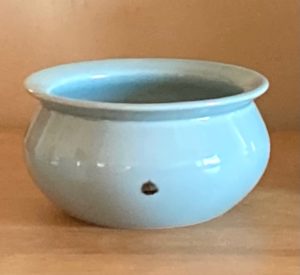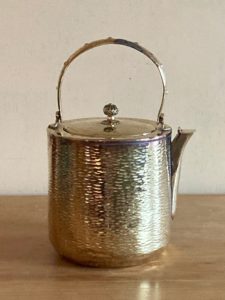Tea in September

The ten-mae dō-gu, 點前道具, offer-fore way-tools: fu-ro – kama, 風炉 釜, wind-hearth – kettle; ‘Yoshi-no dana’, 吉野棚, ‘Luck-field shelf’; mizu-sashi, 水指, water-indicate; on top of the stand, cha-ki, 茶器, tea-container; hi-shaku, 柄杓, handle-ladle; futa-oki, 蓋置, lid-place. On the floor is a mizu-tsugi, 水次, water-next, with cha-kin, 茶巾, tea-cloth.
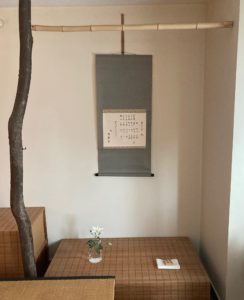
Rikyū wrote that when having Tea for those who have been admiring cherry blossoms, there should be no objects or images of the cherry blossoms in the tearoom. Hence, no images of the moon in the tokonoma.
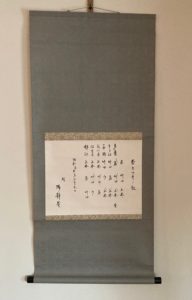
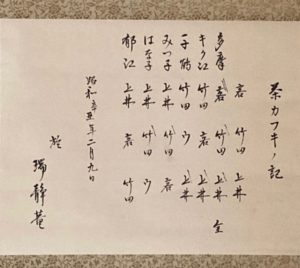
Kake-mono, 掛物, hang-thing, record of Cha-kabuki no ki, 茶カブキノ記, Tea-test’s record, for six participants judging the differences between three kinds of tea, held on Shō-wa, 昭和, Bright-harmony, Kanoto Ushi-doshi, 辛丑年, Hot spice (Metal ‘s young brother) Ox Year, 1961. The mounting, hyō-gu, 表具, front-tool, is simple, paper with the two printed paper ichi-mon-ji, 一文字, one-letter-character, at the top and bottom of the hon-shi, 本紙, main-paper.
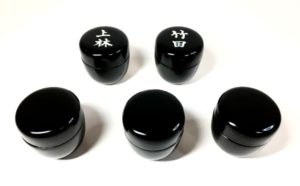
There is the tradition of identifying the two main samplers of koi-cha, 濃茶, thick-tea, as representing Take-da, 竹田, Bamboo-field, and Kan-bayashi, 上林, Upper-grove. However, some identify the names of the actual producers of the teas. The third unknown tea, kyaku, 客, guest, is most often a tea for usu-cha, 薄茶, thin-tea. It is identified on the record by the Katakana letter u, ウ, which is the top part of the Kanji for kyaku, 客.
The tea grower and producer, Kan-bayashi, 上林, Upper-grove, was a close acquaintance of Rikyū’s, and his company in Uji provides teas of fine quality to this day.
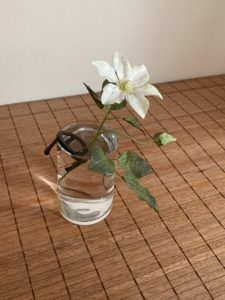
The flower is held in a bronze go-toku futa-oki, 五徳蓋置, five-virtue lid-place, hooked on the rim of the vase. In arranging cha-bana, 茶花, tea-flower, there are very few options for aids in displaying the flowers. A stick placed across the opening is standard. But never a ken-zan, 剣山, sword-mountain, a weight with upright needles to hold flowers. A gotoku futaoki is permitted. The flower container should be filled to almost over-flowing, so that at the conclusion of the Tea gathering the water will have partially evaporated, and the level of the water has diminished showing the passage of time.

The lines of the character are like the earthwork borders of ricefields, and so the allusion to water is to protect against fire in the hearth.
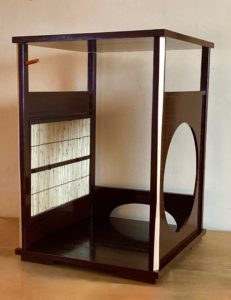
‘Yoshi-no dana’, 吉野棚, ‘Luck-field shelf’, composed of a ji-ita, 地板, earth-board, and ten-ita, 天板, heaven-board, supported on four corner hashira, 柱, posts, with a large circular window on the right side and a reed panel, that may be replaced by a with papered screen, shō-ji, 障子, hinder-of, in winter. The posts are made of Yoshino hinoki, 檜, cypress, that are partially planed to reveal the wood: the tana is covered with Shun-kei nuri, 春慶塗, lacquer. A panel at the back has an arched kushi-gata, 櫛形, comb-shape, opening.
The tana was created by En-nō-sai, 圓能斎, Circle-art-abstain, XIII Iemoto, Urasenke, who was inspired by the Tea hut of Yoshi-no Ta-yū, 吉野太夫, Luck-field Grand-spouse, located at Kō-dai-ji, 高台寺, High-support-temple, Kyōto. The Tea hut, named, I-hō-an, 遺芳庵, Linger-fragrance-hut, has a ni-jō, 二畳, two-mat, Tearoom that has a circular window that is nearly the size of the wall. The large circle must have fascinated Ennōsai, as his name includes ‘circle’. The round window has two large shōji that can be opened only very slightly, giving an intimate atmosphere. Yoshi-no Ta-yū, was an extraordinarily renown courtesan of the 17th century. Her life and associations with Japanese culture and Chanoyu are a subject found elsewhere.
This tana has a bamboo kugi, 釘, nail, attached to the upper part of the left front post, which is to hang the ha-bōki, 羽箒, feather-broom, shi-fuku, 仕覆, work-cover, of the cha-ire, 茶入, tea-receptacle, and the hi-shaku, 柄杓, handle-ladle. The chaire represents the sun, Tai-Yō, 太陽, Great-Yang, and is displayed on the ten-ita, 天板, heaven-board of the dai-su, 台子, support-of. The simple hishaku is the tsuki-gata, 月形, moon-shape, because of the crescent cut in the cup where it is joined by the handle. In a poetic way, the shifuku and the hishaku are like the sun and the moon suspended between earth and heaven.
It should be remembered that the simple hishaku is called tsuki-gata, 月形, moon-shape, as it has a crescent cut where the handle joins the gō/cup. The teishu, when handling the hishaku, ‘handles’ the moon. Only half of the water in the gō is used to make a bowl of Tea, which could suggest a han-getsu, 半月, half-moon. The Rikyū-gata chū-natsume, 利休形中棗, Rikyū-style middle-jujube, tea container is held, according to Rikyū, with the hand covering only half of the container, which is called han-getsu. Also, when making usucha with the Rikyū-gata chū-natsume, only half of the tea in the container may be used to make eight bowls of thin tea.
All tana have their origins in the dai-su, 台子, support-of, and according to tradition, the four hashira, 柱, posts, are identified with the four seasons. The far right corner is Ri-sshun, 立春, Start-spring; near right is Ri-kka, 立夏, Start-summer; near left is Ri-sshu, 立秋, Start-autumn; and back left is Ri-ttō, 立冬, Start-winter. So, the hook on the near left corner post of the tana is identified with the start of Autumn, and thus, the autumn sun and moon.
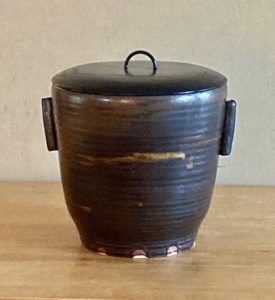
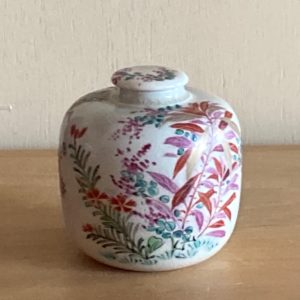
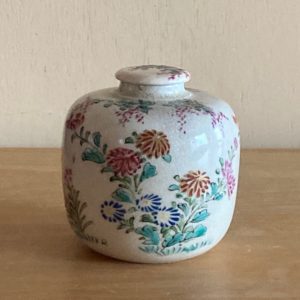
Left: small tsubo, 壺, jar, soft paste ceramic, with iro-e kusa-bana-mon, 色絵草花文, color-picture grass-flower-design, Satsu-ma yaki, 薩摩焼, Salvation-polish fired, right: opposite side of the jar, by Tai-zan Yo-he-i, 帯山与兵衛, Sash-mountain Give-soldier-defense, mid-19th century; h. 2.6 sun kane-jaku. When using a black lacquered natsume, 棗, jujube, for preparing koi-cha, 濃茶, thick-tea, it is the custom to use a container unlike a natsume as an usu-ki, 薄器, thin (tea)-container. Therefore, the choice of the highly decorative Satsuma jar is the container for thin tea powder. The jar is appropriate for the season as it is decorated with designs of autumn flowers; hagi, 萩, bush clover, nadeshi-ko, 撫子, stroke-child, pink, kiku, 菊, chrysanthemum, etc.
Aki no nana kusa, 秋の七草, autumn ’s seven grasses, are an Asuka period gathering of flowers of the autumn season, several of which are depicted on the Satsuma jar. There is a spring assembly of plants called haru no nana kusa, 春の七草, spring’s seven grasses, which are young herbs chopped and blended into a rice gruel, kayu, 粥.
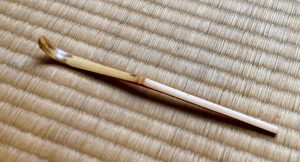

The bowl was made for the 750th anniversary of the founding of Kō-san-ji, 高山寺, High-mountain-temple. The design of the hare is taken from the temple’s great 13th century treasure of the ‘Chō-jū-gi-ga’, 鳥獣戯画, Bird-beast-frolic-picture, picture scroll of drawings of animals enacting and characterizing human behavior. The potter, Kondō, was a Living National Treasure. The chawan was a gift from the wife of abbot of Kōsanji.
The temple of Kōsanji is located in the northwest Kyōto at Toga-nō, 栂尾, Hemlock-tail, and was founded 1206 by Myō-e, 明恵, Bright-enlightenment. In 1191, his friend, Ei-sai Zen-shi, 栄西禅師, Splendor-west Zen-master, had brought tea seeds from China, gave them to him, who planted them on the temple grounds. Eisai also introduced the Zen sect to Japan. There is some confusion about the reading of the name of the temple – Kō-san-ji and Kō-zan-ji. The temple itself reads the name Kōsanji.
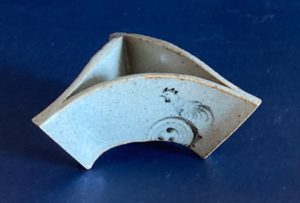
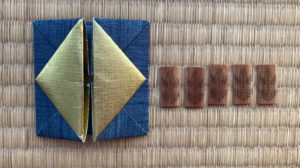
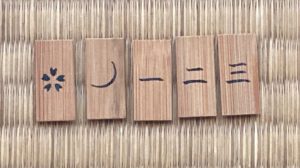
Utensils for practicing Ka-getsu, 花月, Flower-moon, from left: ori-sue, 折据, fold-set, paper folder, and fuda, 札, ‘cards’. Right: fuda, 札, cards, with design of a hana, 花, flower, tsuki, 月, moon, and the numbers ichi, 一, one, ni, 二, two, san, 三, three. Kagetsu and the other Tea exercises can be enjoyed at any time of the year.
The moon plays a role in Chanoyu in the ceremonial presentations of Tea called Shichi-ji-shiki, 七事式, Seven-matter-ceremony. These exercises were created in the 18th century by the 7th generation master of Omote-sen-ke, 表千家, Front-thousand-family, Jo-shin-sai, 如心斎, Like-heart-abstain, and his younger brother Yū-gen-sai, 又玄斎, Again-mystery-abstain, who became the 8th generation master of Urasenke. They worked together with their Zen master Mu-gaku Sō-en, 無学宗衍, No-learn Sect-overflow, abbot of Gyoku-rin-in, 玉林院, Jade-grove-temple, of Dai-toku-ji, 大徳寺, Great-virtue-temple, Kyōto.
The basic presentation is called Ka-getsu, 花月, Flower-moon; Hira Ka-getsu, 平花月, Plain Flower-moon. Five participants use five small bamboo fuda, 札, ‘cards’, with designs of a hana, 花, flower, tsuki, 月, moon, and the numbers ichi, 一, one, ni, 二, two, san, 三, three. The front side of each has the design of a matsu no eda, 松の枝, pine’s branch. The role that each participant is to play in the procedure is determined by drawing a card from a paper folder, ori-sue, 折据, fold-set. The hana, determines the teishu, 亭主, house-master, who prepares the tea: the tsuki determines the shō-kyaku, 初客, first-guest, and in the course of the rite determines the guest who will drink the bowl of tea. The numbers one, two, and three determine the order of the other guests. Four bowls of usucha are prepared during the ceremony, and as there are five participants, one of them will not get a bowl of tea. The fuda are kept in the orisue, and passed among the guests who draw again to determine the successive roles of tea preparer and tea drinker.
It may be a coincidence that Kagetsu identifies the moon with the chawan, and subsequently with tea. When first determining each participant’s role by drawing the fuda, the first to call out is hana, followed by tsuki, and then ichi, ni, san. In the course of the procedure, the first to be called out is tsuki, followed by hana; no numbers are called, but the acting teishu calls out matsu, 松, pine. Thus, the moon/tea takes precedence.
In Japan, the most beautiful things are setsu getsu ka, 雪月花, snow moon flower (cherry). This may be one of the sources for the selection of imagery for the creation of Kagetsu.
Procedures such as Kagetsu were in part created for groups of people learning about Chanoyu and practicing the preparation of Tea. While one person is presenting ten-mae, 點前, offer-fore, the others are guests to drink tea, others watch and learn, ken-gaku, 見学, see-learn. The group endeavors were created to provide activities for the larger number of persons to participate. These procedures became, and are a great part of the study and practice of Chanoyu. The Shichijishiki were followed by seven other variations of Kagetsu, and each Iemoto creates a new Tea procedure to add to the list, which is presented at the first memorial of its creator.
